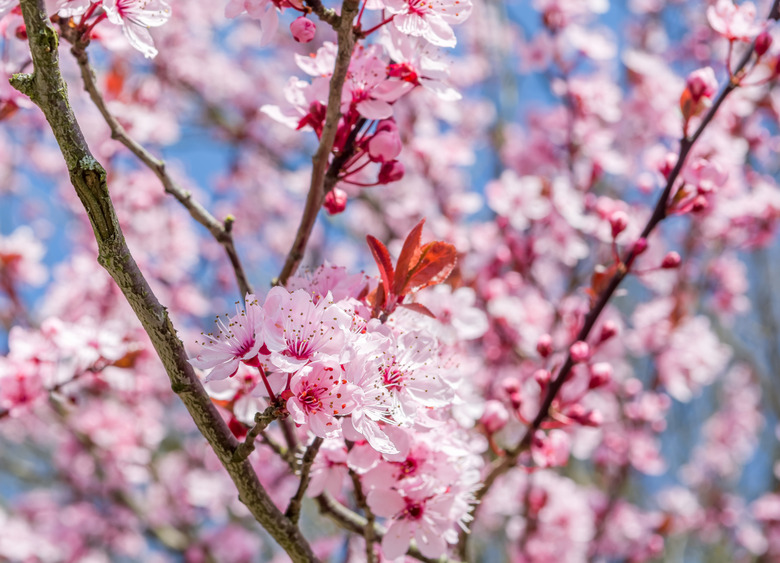Thundercloud Plum Tree Care
Also known as cherry plum, 'Thundercloud' (Prunus cerasifera 'Thundercloud') is a striking deciduous plum cultivar that boasts dark purple leaves, scores of early spring booms and small edible plums. Even with proper care and maintenance, 'Thundercloud' is a short-lived tree that usually begins to decline after 10 to 15 years.
Plant in a Sunny Site
'Thundercloud' grows in U.S. Department of Agriculture plant hardiness zones 5 through 8, where it will grow in full or partial sun. The rich purple leaves will be at their most vibrant in a spot with full sun — in shade leaves will turn greenish rather than purple. If you're planting multiple plums, provide 18 to 22 feet of space in between trees. Fruit and foliage can create a mess, so plant the tree away from walkways and patios to avoid extra clean-up.
Use Well-Draining Soil
Plant 'Thundercloud' in a well-draining soil. In poor, compact soil, 'Thundercloud' is more likely to attract boring insects. Poorly draining soil also increases the risk of fungal diseases such as rot. Water regularly to keep the soil moist, but not waterlogged or flooded. 'Thundercloud' is moderately drought tolerant but will become stressed during long dry periods.
- Also known as cherry plum, 'Thundercloud' (Prunus cerasifera 'Thundercloud') is a striking deciduous plum cultivar that boasts dark purple leaves, scores of early spring booms and small edible plums.
- The rich purple leaves will be at their most vibrant in a spot with full sun — in shade leaves will turn greenish rather than purple.
Fertilize Regularly
During the plum's first year, fertilize in early spring with 1 cup of a 10-10-10 fertilizer spread evenly in a circle with a diameter of about 3 feet. Fertilize again with 1/2 cup of ammonium nitrate or calcium nitrate in a circle about 2 feet in diameter. Always water the area well after spreading fertilizer.
From the second year on, fertilize in early March and early August. In March, apply 1 cup of a 10-10-10 fertilizer per year of tree's age, not exceeding 12 cups. In August, apply 1 cup of calcium nitrate or ammonium nitrate per year of tree's age, not exceeding 6 cups. Apply fertilizer in a circle as wide as the tree's canopy, keeping fertilizer from concentrating next to the trunk. Store unused fertilizer in a secure location away from children and pets.
- During the plum's first year, fertilize in early spring with 1 cup of a 10-10-10 fertilizer spread evenly in a circle with a diameter of about 3 feet.
Check for Pests
'Thundercloud' is susceptible to a wide range of pest infestations. Pests such as scale insects, cottony or hard insects that form dense colonies on branches; mites, tiny sap-sucking pests; aphids, sap-sucking insects that feed on new growth; and tent caterpillars, which chew holes in leaves, may all be controlled with horticultural oil.
Mix 2 1/2 to 7 1/2 tablespoons of horticultural oil in 1 gallon of water and pour it into a backpack sprayer. Wear long sleeves, long pants and goggles and spray evenly over to wet the tops and undersides of branches, main limbs and trunk. Apply when the trees are dormant — before blossom buds show green — or when trees are delayed dormant — when blossom buds have emerged 1/4 to 1/2 inch. Store unused oil away from children and pets and follow the label's instructions carefully.
Keep It Clean and Tidy
Common plum fungal diseases such as black knot, which causes warty growths on 'Thundercloud' branches, and brown rot, which causes cankers and rotten fruit, can be managed by following good sanitation practices. Rake up and destroy fallen fruits and leaves, which may harbor diseases, and prune out and destroy limbs with fungal growth. Remove any dried out plums that remain on the tree.
- 'Thundercloud' is susceptible to a wide range of pest infestations.
- Common plum fungal diseases such as black knot, which causes warty growths on 'Thundercloud' branches, and brown rot, which causes cankers and rotten fruit, can be managed by following good sanitation practices.
Thundercloud Plum Tree Is Going Into Shock -- What Can I Do To Help It?
Transplanted trees lose large amounts of roots, which must be regenerated over time for the plant to receive adequate water. Water so that the soil is moist, but not waterlogged or flooded. Remove weeds and grass from around the tree and mulch with 3 to 4 inches of wood chips or bark to help suppress young competitive plants, as well as regulate soil temperatures and conserve moisture. According to Montana State University, it may take several years for new roots to push through very compacted clay soils enough for stem and canopy growth to resume at a normal rate. Without proper planting from the beginning, some trees may never recover and may simply fail to thrive. Proper planting is critical to the tree's future success. "
Warning
To reduce possible damage to the plum tree, do not apply horticultural oil when plants are stressed or developing new shoot growth. Do not apply horticultural oil when temperatures are above 100 degrees Fahrenheit or during freezing conditions.
Tip
To prevent the spread of fungal spores to healthy plants, disinfect pruning equipment by soaking tools for five minutes in a solution that is equal parts rubbing alcohol and water. Rinse with clean water and allow the tools to air dry.
References
- Clemson Cooperative Extension: Plum
- Purdue University: Fruit Diseases: Brown Rot on Tree Fruit in the Home Orchard
- Washington State University: Thundercloud Flowering Plum
- Missouri Botanical Garden: Prunus Cerasifera 'Thundercloud'
- Washington State University: Thundercloud Flowering Plum
- Clemson Extension: Newly Planted Trees: Strategies for Survival
- Purdue University: Transplant Shock of Trees and Shrubs
- Missouri Botanical Garden: Prunus Cerasifera 'Thundercloud'
